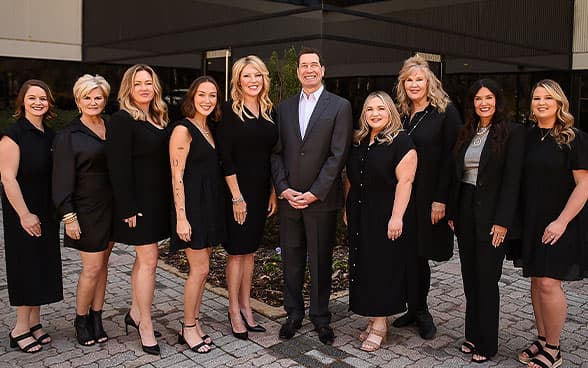Gynecomastia 101: What is Male Excessive Breast Tissue & Do I Have It?
February 26, 2019 - Rhys Branman, MD
Did you know that an estimated two-thirds of adult men will develop some degree of gynecomastia, or enlarged male breasts, at some point in their lives? About 50% of teenage boys experience this too.
While usually harmless from a medical standpoint, gynecomastia can have significant emotional and psychological effects. The good news is that gynecomastia can usually be treated successfully—and often permanently—with male breast reduction surgery. If you think you might have gynecomastia, the info below will help you better understand what’s going on and your options for treatment.
Do I have gynecomastia?
Gynecomastia often results from hormonal imbalances. If man has relatively higher estrogen levels compared to testosterone, he may experience some breast enlargement. This is why gynecomastia affects so many teens; hormone shifts during the teenage years can cause a temporary imbalance resulting in excess estrogen (hence gynecomastia in teens often subsides in time).
Other causes of enlarged male breasts include taking certain drugs or medications (i.e., anabolic steroids, anti-androgens, etc.), carrying extra weight, or having a medical condition, such as liver disease or thyroid disease.
Losing weight will not reduce the size of glandular male breast tissue or remove all fat from the chest—this is why many men find slimming down doesn’t eliminate their enlarged male breasts.
If you think you have gynecomastia, the first step is to talk to your doctor to rule out or treat any medical conditions.
Next, if the appearance of your chest bothers you, consult with an experienced cosmetic surgeon to discuss your options for treatment. They will likely base treatment on whether the excess tissue is mostly fat, mostly glandular tissue, or both—the most common situation, which I call Male Excessive Breast Tissue (Male EBT™).
Signs you may have Male EBT™
In some cases, if a patient is significantly overweight or obese, losing weight can resolve gynecomastia well enough to where it no longer is a concern. However, losing weight will not affect glandular tissue, and oftentimes, will not improve excess fat well enough to resolve the appearance of male breasts—especially if you are genetically predisposed to accumulate fat in your chest. You may be dealing with Male EBT™ if you have experienced any of the following:
- You are a healthy adult with enlarged breasts
- Your excessive breast tissue can’t be explained by weight issues
- Losing weight and/or exercising have done little to help you get a flatter, firmer chest
Is it chest fat? Is it breast tissue? Does this matter?
Some doctors refer to Male EBT™ that is mainly excess fat as “pseudogynecomastia” and excess glandular tissue as “true gynecomastia.” To be honest, I’m not crazy about these terms and don’t use them with my Little Rock male breast reduction patients. First, the vast majority of men with gynecomastia have an excess of both fat and glandular breast tissue. Second, these terms imply that one patient has a “true” concern and the other does not.
Using the TRTMI™ technique for male breast reduction, I can treat Male EBT™ (both excess fat and glandular tissue) through a liposuction-based procedure for nicely sculpted results as well as a reduced recovery time and virtually invisible scars.
To me, if gynecomastia is affecting your life in a negative way, that’s a true concern—whether it’s excess fat or glandular tissue only matters insofar as the tools and techniques I use to treat the issue. There is also no minimum amount of Male EBT™ that a patient must have to be a candidate for treatment—if it bothers you or keeps you from fully enjoying your life, then it is worth looking into male breast reduction.
Options to treat Male EBT™ and gynecomastia
Male breast reduction surgery is the single most effective treatment for gynecomastia. The procedure should be tailored to your specific needs, based on the amount and nature of Male EBT™ present. In general, your options will include:
- Chest liposuction: best suited to treat Male EBT™ that is primarily fat, with minimal glandular tissue
- Tissue excision (often with liposuction): patients with a significant amount of excess glandular tissue and/or excess skin will usually qualify for this procedure. Even when using excision, most experienced male breast reduction surgeons will incorporate liposuction to help sculpt the best possible chest shape.
- TRTMI™ (Tissue Removal Through Minimal Incisions): this is a technique I have developed based on many years of helping Little Rock gynecomastia surgery patients, knowing avoiding scars is a top priority for patients. Using the TRTMI™ technique, I can remove both excess fat and glandular tissue through a liposuction-like process that requires only a tiny incision on each side of the chest. With this method, I can provide nicely sculpted results—and patients enjoy a reduced recovery time and virtually invisible scars.
Have questions about gynecomastia or Male EBT™? I’m here to help.
I understand that gynecomastia can be difficult to talk about, especially if you are the one suffering from it, but you don’t need to live with it. Having been a cosmetic surgeon for over 20 years, I have helped many men address their Male EBT™ and go on to feel more confident in their bodies. During a personal, private consultation, I can help you understand your treatment options so you can decide if male breast reduction is right for you. Please call 501-227-0707 to make an appointment.

